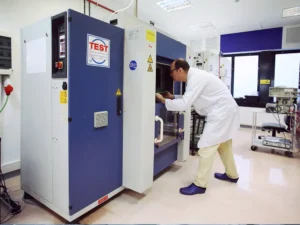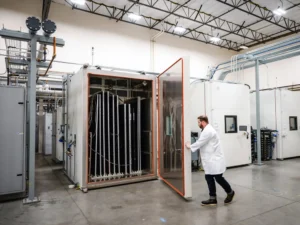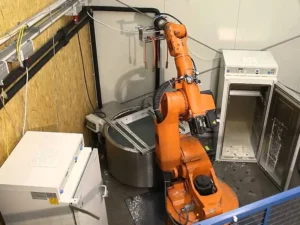Temperature cycling tests have become an integral part of many industries. It allows them to make and launch products ready for real-life usage. This test helps to examine the product under extraordinarily high and low temperatures. It tells us how the product will behave when it goes to the public.
However, the mechanism of the thermal cycling test is least understood. It might seem like a simple test that includes increasing and decreasing temperature. However, there is a more complex process behind its work. Let’s dive deeper and discuss everything from its introduction to working mechanisms.
What is a Temperature Cycling Test?

This test helps engineers determine the product’s actual resilience. It uses special environmental chambers. The product placed in the chamber undergoes sudden increases and decreases in temperature. If it is weak, it cracks due to contraction and expansion.
As you know, the product undergoes various conditions in the real world. The engineers aim to make them strong enough to bear all those extreme temperatures. Thus, they check the product quality through this testing. The environmental chambers offer temperature changes just like in the real world.
It gives a good idea of how the product will behave under different temperatures. Temperature cycling tests can be done on every kind of product. Many modern industries are adopting this testing. This helps them to increase the quality and durability of their products.
What makes this testing popular is that it offers quick output. There is no need to wait for hours. This feature makes the testing ideal for industries that quickly launch products. The old and conventional methods used take much time and resources for such testing.
Impact of Temperature Cycling Test
As I mentioned, the thermal cycling test has revolutionized product testing. All the manufacturers rely on this test to meet international standards. They can be more confident while launching durable products.
This temperature cycling test has decreased product recalls and customer complaints. It also saves companies time and resources by identifying product flaws. In the past, the price of testing chambers was high, which was a drawback.
However, things have changed now. Test chambers and other equipment prices have also decreased in recent years. Small manufacturers can use this test to ensure quality. Many industries, from automobiles to aerospace, now incorporate these tests into product development.
Point to Remember: Different testing methods are available. For example, the temperature shock and temperature cycle methods serve the same purpose. However, their ways of working and efficiency are different.
How Does the Temperature Cycling Test Work?

As mentioned, the thermal cycling test is conducted in environmental chambers. These chambers simulate rapid temperature changes like the real world. You might wonder how they can quickly shift from high to low temperatures.
Let’s discuss the logic behind the sudden temperature shifts. These chambers consist of heating and cooling elements. These elements can quickly alter the temperature from one extreme to another extreme. The product that needs to be tested is placed in such a chamber and exposed to different temperatures.
Another question is: how long does a product undergo a specific temperature? This usually depends on the type of product and its strength. Let’s discuss the exact process or phase of product testing in these chambers.
1- Heating Phase
First, the product placed in the chamber faces the increase in temperature. The chamber slowly raises the temperature. It raises it to the top limit in the test profile. Not to forget that this heating is not random.
Instead, it raises the temperature strategically. Simply put, the heat goes up and tries to emulate the temperature that a product encounters. This phase tests the product’s ability to expand without compromising its structural integrity. If a product shows cracks or damage, it indicates weakness, and vice versa.
2- Dwell Time
Dwell time is a simple concept. However, many people don’t understand it. Once the heat reaches the upper-temperature limit, the chamber maintains it for a while. This period of maintaining a specific temperature is called dwell time.
This dwell time ensures that heat thoroughly permeates the product. Due to this, the engineers understand and accurately assess the product’s durability. If the product remains in good shape even after dwell time, it is resilient and durable.
3- Cooling Phase
This is the last step of the thermal cycling test. The temperature in the environmental chambers starts to drop. Remember that this drop from very high temperatures is sudden to check the product’s behavior. The chamber cools down to the lower temperature limit of the test profile.
So, the product gets exposed from very high and low temperatures. If the product is weaker, it will break or crack. However, strong and durable products don’t show issues at this low temperature. The product that remains unaffected during both phases is considered top-notch.
Notably, these phases repeat for several cycles. The product is continuously monitored for any signs of failure. Examples include cracks, warping, or other physical deformations. The question is: What happens to the product that fails in this test?
Product failure is not considered a mission failure. Instead, it allows engineers to identify weaknesses and make changes and improvements. They make the necessary changes and retest the product. Without these tests, the product would have gone into the market. This would have affected the customer experience.
Standards and Specifications
Some respectful organizations have set these standards. Following these standards ensures products are tested under universal conditions. It makes it easier for industries to compare their products with others in the market.
Some of the commonly followed standards for temperature cycling tests are:
- ISO 16750
- ASTM E1447
- IEC 60068-2-14
- MIL-STD 883E, Method 1010.8
These standards define the test profile and equipment specifications. By following standards, you come to know different parameter values. Those include test procedures, dwell times, temperature range, and the number of cycles.
Aerospace and automobile industries usually follow the MIL-STD 883E, Method 1010.8 standard. These industries handle fragile parts. Small durability issues can lead to severe issues in such industries. Therefore, parts must endure high temperatures during use. So they are treated and tested more strictly.
Benefits of Thermal Cycling Test

As I mentioned above, the temperature cycling test has changed many industries. Before its introduction, product development took time and effort. Let’s go into more detail and discuss the key benefits of this test.
- The test accurately simulates real-world conditions. It gives exact information about the product’s behavior when it goes into masses. It becomes ideal for the manufacturers to spot the weaknesses and remove them. In this way, the manufacturers can launch products with improved durability.
- It helps spot weak areas in the products, which the engineers improve before they launch. It saves companies and manufacturers from potential product failure and customer dissatisfaction.
- It shortens the product’s development time. It does this by providing reliable data fast. Without this test, the companies had to arrange more conventional testing methods. Those are both expensive and less reliable as well.
- The thermal cycling test is not very expensive. If you buy the chamber, the testing cost will be minimal. This will save the overall cost needed for product development. You will be able to test as many products as you wish.
- This test can evaluate products in many industries and domains. From small manufacturers to big industries, this test has found its place. It is considered one of the most versatile testing methods. Moreover, it is accepted at the international level.
Frequently Asked Questions
What industries commonly use Temperature Cycling Tests?
Many industries actively use thermal cycling tests. Examples include electronics, automotive, and aerospace. The tests are becoming more common. The trend is expected to continue.
What is the ramp rate in thermal cycling tests?
The speed at which the temperature changes from one extreme to the other. Suppose a chamber is at full heat. How long will it take to go into a highly relaxed mode? This time taken from extreme heat to cool is called the ramp rate.
What are the types of test chambers?
Generally, two types of test chambers are available. The first is an Elevator-type Chamber, suitable for quick temperature shifts. The second is a Single-Temperature Cycle Chamber used for controlled thermal shifts.
Conclusion
The thermal cycling test is beneficial. It has significantly changed many small to large industries. It has become a universal and reliable product testing procedure. Understanding how it works is crucial for careful usage. We have discussed everything related to thermal testing. You’ll learn from the basic introduction to the mechanism.